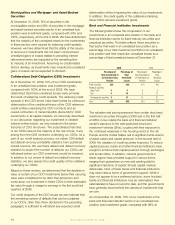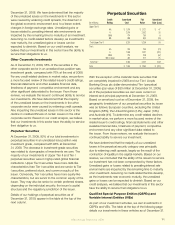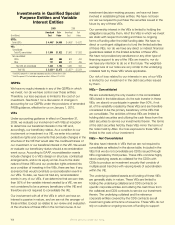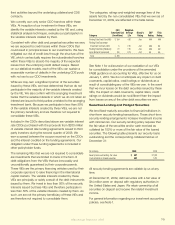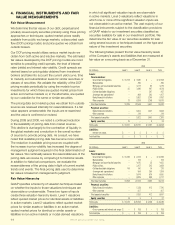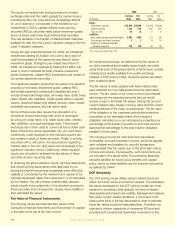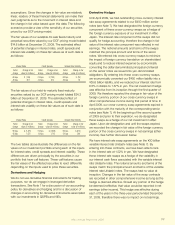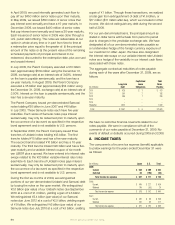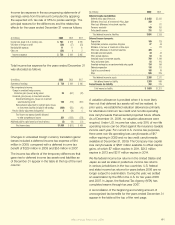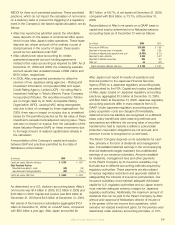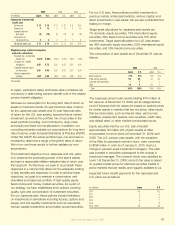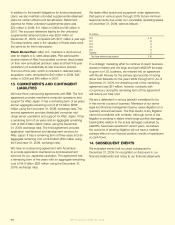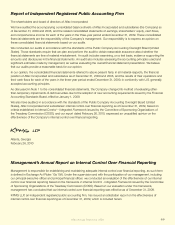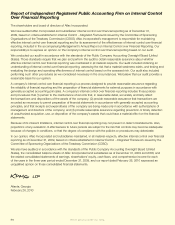Aflac 2009 Annual Report Download - page 84
Download and view the complete annual report
Please find page 84 of the 2009 Aflac annual report below. You can navigate through the pages in the report by either clicking on the pages listed below, or by using the keyword search tool below to find specific information within the annual report.
We’ve got you under our wing.
80
In April 2009, we used internally generated cash ow to
pay off our $450 million senior notes upon their maturity.
In May 2009, we issued $850 million of senior notes that
pay interest semi-annually and have a 10-year maturity. In
December 2009, we issued $400 million of senior notes
that pay interest semi-annually and have a 30-year maturity.
Each issuance of senior notes in 2009 was done through a
U.S. public debt offering. The notes are redeemable at our
option in whole at any time or in part from time to time at
a redemption price equal to the greater of: (i) the principal
amount of the notes or (ii) the present value of the remaining
scheduled payments of principal and interest to be
redeemed, discounted to the redemption date, plus accrued
and unpaid interest.
In July 2009, the Parent Company executed a ¥10 billion
loan (approximately $109 million using the December 31,
2009, exchange rate) at an interest rate of 3.60%. Interest
on the loan is payable semiannually, and the loan has a
six-year maturity. In August 2009, the Parent Company
executed a ¥5 billion loan (approximately $54 million using
the December 31, 2009, exchange rate) at an interest rate of
3.00%. Interest on the loan is payable semiannually, and the
loan has a six-year maturity.
The Parent Company issued yen-denominated Samurai
notes totaling ¥30 billion in June 2007 and ¥40 billion
in July 2005. These Samurai notes each have ve-year
maturities. Each series of Samurai notes pays interest
semiannually, may only be redeemed prior to maturity upon
the occurrence of a tax event as specied in the respective
bond agreement and is not available to U.S. persons.
In September 2006, the Parent Company issued three
tranches of Uridashi notes totaling ¥45 billion. The rst
tranche totaled ¥15 billion and has a ve-year maturity.
The second tranche totaled ¥10 billion and has a 10-year
maturity. The third tranche totaled ¥20 billion and has a ve-
year maturity and a variable interest coupon of six-month
yen LIBOR plus a spread. We have entered into interest rate
swaps related to the ¥20 billion variable interest rate notes
(see Note 4). Each tranche of Uridashi notes pays interest
semiannually, may only be redeemed prior to maturity upon
the occurrence of a tax event as specied in the respective
bond agreement and is not available to U.S. persons.
During the rst six months of 2009, we extinguished
portions of our yen-denominated Uridashi and Samurai debt
by buying the notes on the open market. We extinguished
¥2.0 billion (par value) of our Uridashi notes due September
2016 at a cost of ¥1.4 billion, yielding a gain of ¥.6 billion.
We extinguished ¥3.4 billion (par value) of our Samurai
notes due June 2012 at a cost of ¥2.5 billion, yielding a gain
of ¥.9 billion. We extinguished ¥.6 billion (par value) of our
Samurai notes due July 2010 at a cost of ¥.5 billion, yielding
a gain of ¥.1 billion. Through these transactions, we realized
a total gain from extinguishment of debt of ¥1.6 billion, or
$17 million ($11 million after-tax), which we included in other
income. We did not extinguish any debt during the second
half of 2009.
For our yen-denominated loans, the principal amount as
stated in dollar terms will uctuate from period to period
due to changes in the yen/dollar exchange rate. We have
designated all of our yen-denominated notes payable as
a nonderivative hedge of the foreign currency exposure of
our investment in Aac Japan. We have also designated
the interest rate swaps on our variable interest rate Uridashi
notes as a hedge of the variability in our interest cash ows
associated with these notes.
The aggregate contractual maturities of notes payable
during each of the years after December 31, 2009, are as
follows:
Capitalized Total
Long-term Lease Notes
(In millions) Debt Obligations Payable
2010 $ 428 $ 3 $ 431
2011 380 2 382
2012 289 1 290
2013 – – –
2014 – – –
Thereafter 1,500 – 1,500
Total $ 2,597 $ 6 $ 2,603
We have no restrictive nancial covenants related to our
notes payable. We were in compliance with all of the
covenants of our notes payable at December 31, 2009. No
events of default or defaults occurred during 2009 and 2008.
8. INCOME TAXES
The components of income tax expense (benet) applicable
to pretax earnings for the years ended December 31 were
as follows:
(In millions) Japan U.S. Total
2009:
Current $ 565 $ 265 $ 830
Deferred 62 (154) (92)
Total income tax expense $ 627 $ 111 $ 738
2008:
Current $ 409 $ 227 $ 636
Deferred 109 (85) 24
Total income tax expense $ 518 $ 142 $ 660
2007:
Current $ 450 $ 98 $ 548
Deferred 222 95 317
Total income tax expense $ 672 $ 193 $ 865


